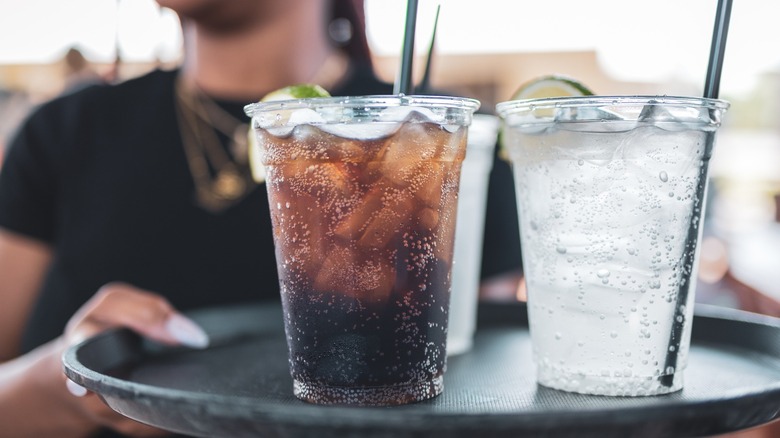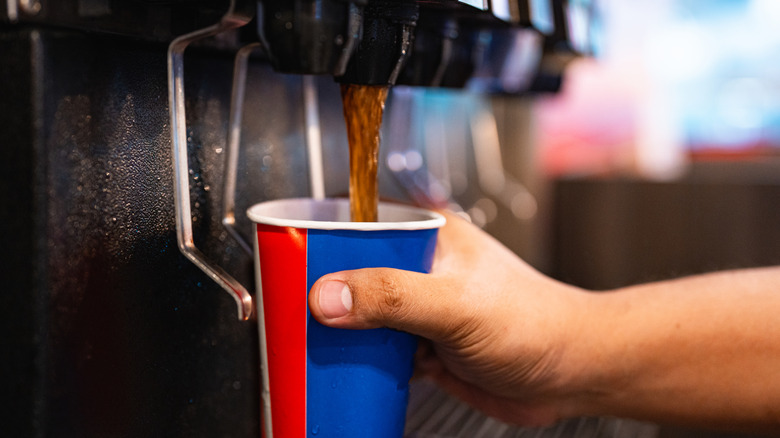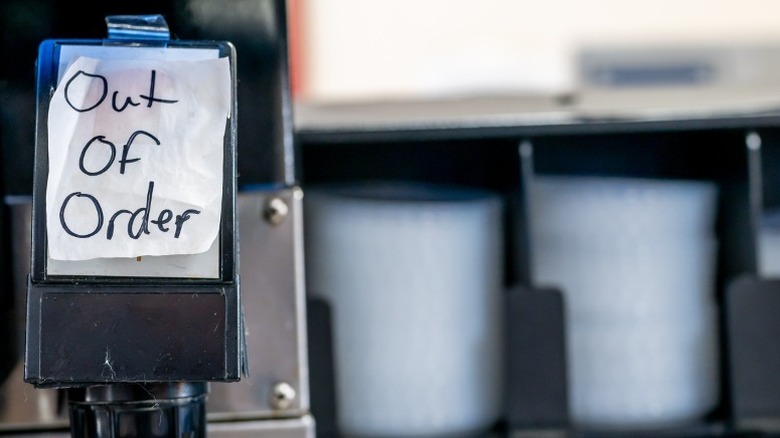Why Fast Food Soda Always Tastes Different
Whether you call it soda or pop, there's no denying that something about fountain drinks makes them taste different from what you get in a can or bottle. And that's because there's a fundamental difference in how they're made.
Manufacturers create bottled and canned sodas with forced carbonation. During the process, they introduce carbon dioxide into the liquid under high pressure, causing it to dissolve into the beverage. When opened, it turns back into a gas, causing the hissing noise and lively bubbles. But between those two actions, a few things can impact the taste. The polymer coating that prevents rust inside canned sodas contributes to a slightly different flavor that some people can detect more than others. Similarly, a chemical used in the manufacture of plastic bottles, acetaldehyde, impacts the flavor of drinks, giving them a faint citrusy taste.
But fountain sodas are mixed to order. When you trigger a soda fountain dispenser, a carbon dioxide tank infuses the water coming into the machine with carbonation. Both the carbonated water and a flavored syrup combine in your cup. The mixture's freshness is one reason fountain soda tastes markedly different. But many other factors also contribute to fast food soda tasting so distinctly unique.
How soda ingredients impact flavor
One of the most important factors is the ratio of syrup to carbonated water, which greatly impacts flavor. The optimum water-to-syrup ratio is 5 to 1, but the restaurant can adjust that as needed to tweak the flavor or increase profits. For instance, McDonald's uses a higher syrup ratio to account for ice melting, which dilutes the flavor. Since most people drink soda right from a can or bottle without ice, they may be accustomed to much sweeter versions. Ice also influences temperature, and lower temperatures help the water retain carbonation, which affects the flavor of soda. That's one reason Sprite tastes better at McDonald's than other places. They chill their syrup and water before mixing it at the fountain.
But even chilling the water would have no impact if McDonald's didn't use filtered water. Because it impacts the flavor — and therefore value — of the beverages, it's likely beverage manufacturers carefully control the quality of the water used for bottled and canned sodas as well. However, fast food sodas may be made with whatever regular tap water is available in your area, heavily influencing the flavor of the soda based on the quality of the local water. That can also make fast food soda taste much different from precisely managed manufactured versions.
Other factors that contribute to soda flavor differences
Similarly, how the soda tastes also depends on whether the machine is correctly calibrated and how careful a restaurant is with maintenance. Those factors can influence the amount of water, syrup, or carbonation in your drink and how well the components stay refrigerated. A lack of maintenance can even lead to some disgusting buildup that rivals the safety hazards of soft-serve machines, with mold and mildew in the lines and nozzles. Definitely not an extra flavor you want in your soda.
But it doesn't end there. How you physically drink your soda matters too. At a fast food restaurant, you're more likely to use a straw, which moderates the amount of soda that hits your tongue as you drink, especially as compared to drinking straight from a bottle or can. Some restaurants may offer wider straws to allow more flavor to hit your tongue. Or you could use silicone or metal straws at home, which also impact the flavor compared to plastic.
Bottled and canned sodas offer something fast food sodas can't: consistency. But fast food soda can offer an experience in which every detail — from preparation to presentation — delivers something you can't replicate with their bottled or canned rivals. Or it can just be a loss leader hastily hooked up and seldom given a second thought — which may be why you like soda at some restaurants better than others.


